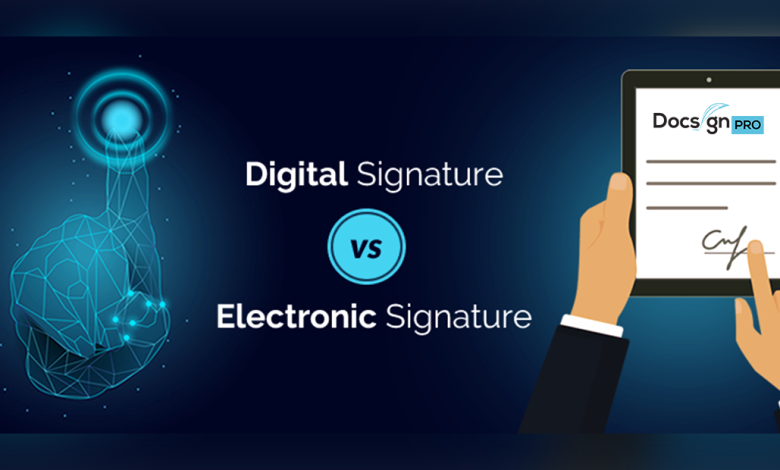Digital Signature And An Electronic Signature!

As society becomes more reliant on digital processes and traditional business mechanisms become more automated, the industry is trying to capitalize on an increasingly tech-savvy consumer. As many electronic communication devices have been introduced to the market over the past decade, companies are under pressure to replace paper-based processes with more efficient models, with digital signature technology leading the way.
What is an electronic signature?
In simple terms, an electronic signature is a signature image, symbol, fingerprint, click, sound, or process used to authenticate a document in place of ink or a handwritten signature. you can use Electronic signatures to agree or accept that you have signed a document by simply pressing a mouse button or typing your name on a completed form.
- An electronically signed agreement becomes legally binding once all parties have signed it.
- Unlike digital signatures, electronic signatures are generally not issued with a digital certificate.
- This makes digital signatures easier to use but can also make them less secure than digital signatures.
When should electronic signatures be used?
Many businesses use electronic signatures for contracts and agreements. For example, your company allows customers to electronically sign financial arrangements, such as loan applications.
Your sales department can electronically sign documents-dailywold for potential customers, and your human resources department can electronically sign documents for new employees.
What is a digital signature?
Digital signatures are part of electronic signatures, but there are significant differences. Digital signatures use algorithms and encryption to sign and authenticate documents.
- While the purpose of digital signatures is solely to authenticate documents, digital signatures also serve the purpose of effectively protecting documents.
- Like digital signatures, digital signatures have legal value and can be more easily verified by the presence of a digital verification certificate.
When are digital signatures used?
Because digital signatures verify the signer’s identity with a digital certificate, this type of signature is an excellent security tool for sensitive data such as financial documents, HIPAA-regulated documents, and other confidential documents and contracts.
Difference between a digital signature and an electronic signature
Although electronic signatures have become commonplace in digital processes, there are still misunderstandings about the place of e-signature technology in this context.
- Since 2000, all people have recognized electronic signature as a legal term in federal law, and for the general public, the same applies to a digital signature.
- However, there are apparent differences between electronic and digital signatures, which you can see in their primary functions.
1. Verification of the authenticity of the signatory
Digital signatures are based on PKI, a technology that verifies the identity of the signer using a digital certificate issued by a trust service provider.
An example is signing a document with an electronic ID. The signatory has exclusive control over the data in their electronic ID, and no one else can use it to create a signature on their behalf.
- In the event of a dispute, a digital signature can authenticate the signatory beyond a reasonable doubt.
- However, this is not the case with formal digital signatures. In these signatures, the signer’s identity does not have verification, or someone has used inappropriate methods, such as email or SMS.
- This method is incorrect because the email account that someone easily compromises.
- Therefore, it is impossible to be 100% sure who actually signed the document.
2. Document integrity
Digital signatures use hash algorithms and public-key cryptography to ensure that anybody has not altered the document after signing. The digital signature is considered invalid if the document has been tampered with.
- In addition, most manufacturers of standard digital signatures cannot detect changes made to a document after someone has signed it.
- However, the exception is the standard electronic signatures that DocuSign has created. Documents with simple electronic signatures also use a hash algorithm to ensure their integrity.
3. Irrevocability
Because a digital signature attests to the signer’s identity and the integrity of the signed document, the signer can’t challenge the signature.
Digital signatures, on the other hand, are quickly challenging. If the evidence is insufficient, it will not stand up in court.
4. Legal value
The eIDAS regulation states that a digital signature has the same legal value as a traditional pen and paper signature; therefore, a valid digital signature always has legal value.
- People can use formal digital signatures as evidence in court. But a judge must determine the legal validity of a signature on a case-by-case basis.
- It is therefore always advisable to use electronic signatures for important business documents such as annual reports, employment contracts, and confidentiality agreements.
- Note that in some cases, a handwritten signature is required. Exceptions to this rule vary between EU member states.
Author Bio
Sally Hickman Green is a 30-year-old who enjoys blogging for electronic signature apps, internet marketing, and social media marketing. She is inspiring and generous in blogging. She has a post-graduate degree in Computer science.




